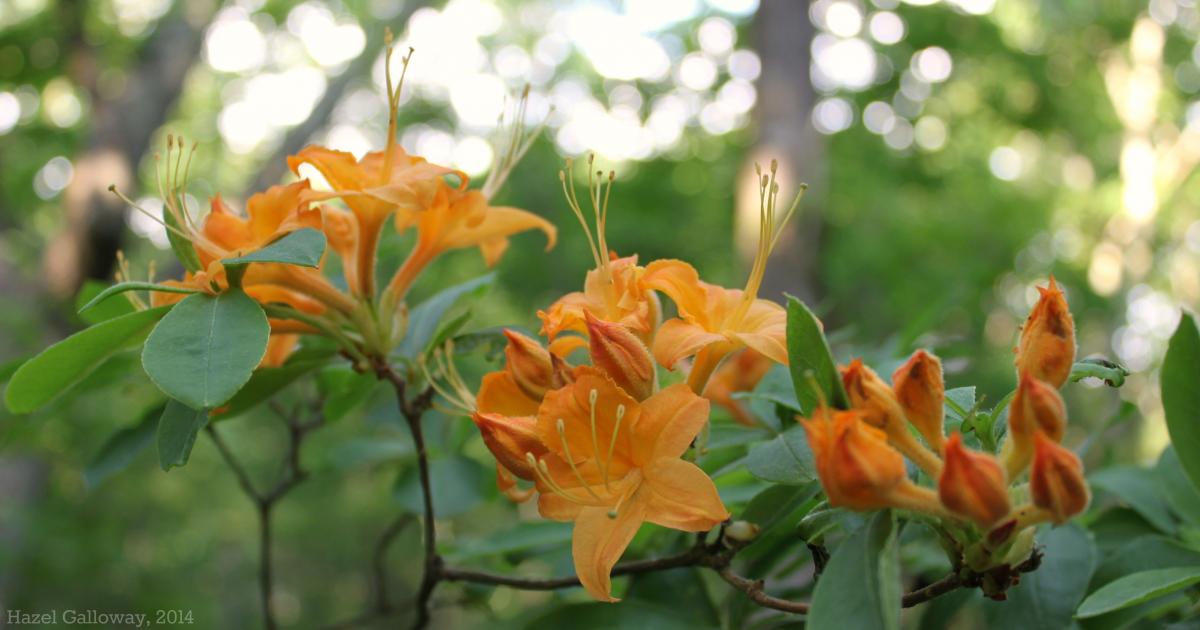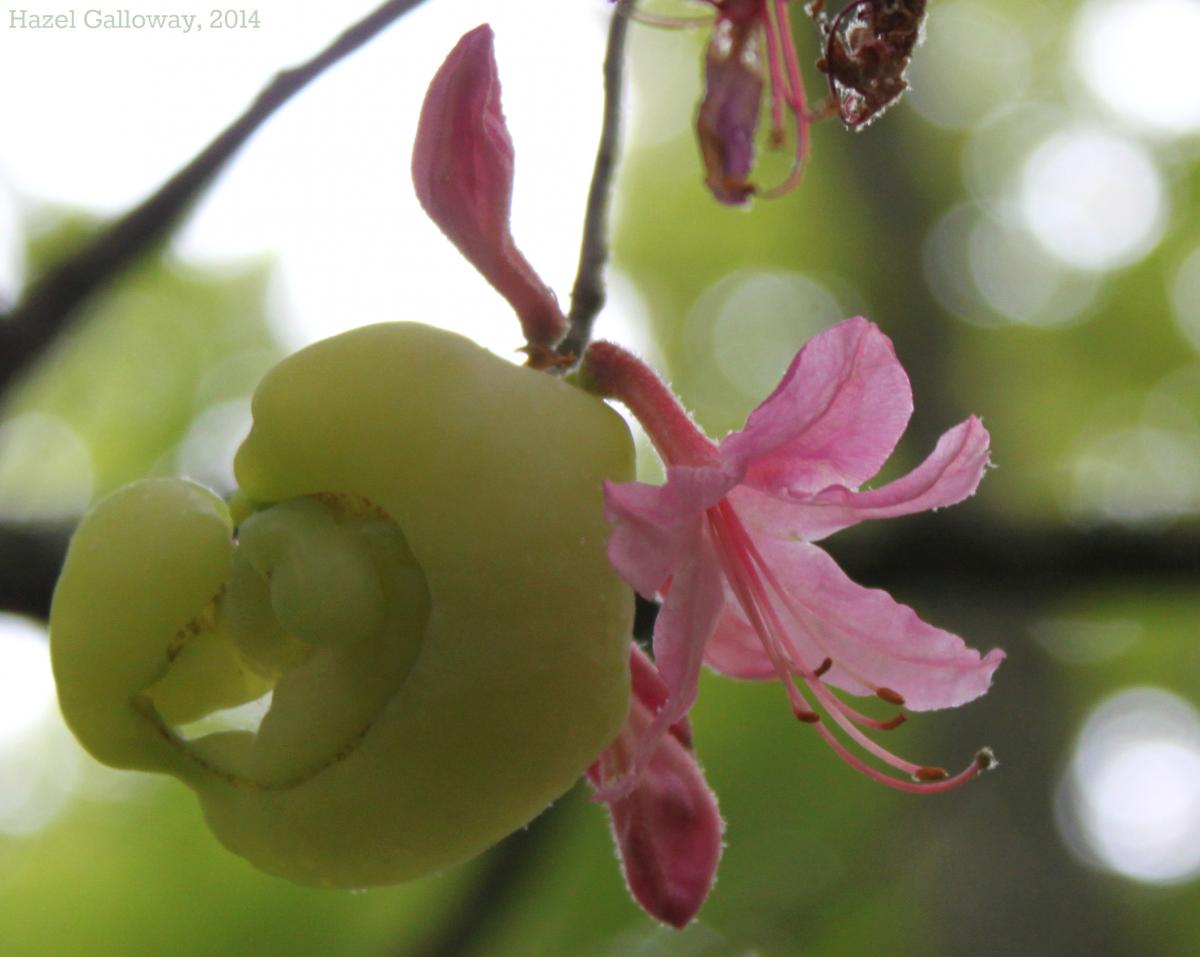Flame Azalea
Rhododendron calendulaceum
The flame azalea is likely the most striking summer wildflower found on the top of the mountain. Although other station regulars such as the great rhododendron (Rhododendron maximum) and other species of wild azalea share its genus, the overwhelming majority of more than 800 Rhododendron species are native to Southeast Asia. They thrive in the moist, acidic soil of the valleys of the Himalayas and the mountains of New Guinea, as well as the islands of Java, Sumatra, Borneo, and the Philippines. By comparison, relatively few species inhabit North America and parts of southern and eastern Europe. The deciduous azaleas as a group (subgenus Pentanthera), appear to be restricted to North America and Asia Minor, with at least seven genetically distinct species endemic to North America.
The flame azalea, although often planted as a horticultural in beds flanked by much-bred cultivars, can be found occurring naturally throughout much of the Appalachian Mountains between 180 to 1500 m (600-5000 ft) of elevation. In the late spring and early summer, it produces striking yellow to orange-red blooms in clusters on the ends of its branches. The funnel-shaped flowers are marked by unusually long stamens, which are often almost three times as long as the corolla tube. However, it is not the fiery color of the blooms—which reportedly have been mistaken for actual flames when densely covering a hillside—which inspire R. calendulaceum’s common name. Rather, just before opening, the expanded buds are said to resemble candle flames.
 The inflorescences coincide with the appearance of delicate, oval-shaped leaves which grow to around 8 cm long and are covered by short hairs on their undersides. Both the leaves and the somewhat hairy, reddish-brown twigs grow in whorls. Although these woody shrubs are decidedly a scattered understory-dweller in this area, they can reach 4.5 m (15 ft) in height on open cliffs and hillsides in their native range and have been known to form large and dense thickets.
The inflorescences coincide with the appearance of delicate, oval-shaped leaves which grow to around 8 cm long and are covered by short hairs on their undersides. Both the leaves and the somewhat hairy, reddish-brown twigs grow in whorls. Although these woody shrubs are decidedly a scattered understory-dweller in this area, they can reach 4.5 m (15 ft) in height on open cliffs and hillsides in their native range and have been known to form large and dense thickets.
Research has been done on this species at MLBS by Lorne Wolfe, who investigated the relationship between the plant and a fungal pathogen, Exobasidium vaccinii. E. vaccinii, which produces large and fleshy galls on infected plants, was found on 10-90% of individuals (depending on the study site) and had immediate negative effects on the azalea’s reproduction. “Diseased inflorescences produced fewer flowers, smaller individual flowers, and had a lower probability of producing fruit….Finally, branches that were diseased in 1997 were more likely to die the following year” (Blair and Wolfe, 1999). A 2007 study by Wolfe concluded that flame azalea blooms are “subject to pollen-induced senescence”—they tend to expire more rapidly once they have been pollinated—and that the amount of fruit set by the plant was greatly increased by hand outcrosses. This suggests that selection for flower life is more dependent on male function than female function.
Historically, infusions of the plant were used by the Cherokee Indians as a gynecological aid, while peeled bark and twigs may have been used to treat areas affected by rheumatism. The fungal galls were used as an occasional food source, said to stave off thirst.
This cutting was taken from an individual growing on the War Spur loop.
Roseshell Azalea
Rhododendron prinophyllum
This pink-flowered azalea, though less common near the station, is closely related to the flame azalea and has a very similar morphology and life history. While it does not usually exceed 3 m, it has been known to reach heights rivalling the flame azalea’s 4.5 m record. It is also found in very similar environments, tending to grow on wooded slopes and ravines at higher elevations.
However, at least four other species of wild azalea on the east coast also sport very similar-looking pink blooms. According to Newcomb’s Wildflower Guide, this species can be distinguished from the most widespread of these, R. periclymenoides, by the presence of hairs covering the undersides of the leaves and by the flower’s strong fragrance. In R. periclymenoides, the pink azalea, hair can only be found on the midribs of the undersides of the leaves, and they are very faintly fragrant, if at all. A second, less common lookalike that overlaps in range is the woolly azalea, R. canescens. It is more difficult to distinguish from R. prinophyllum; Newcomb’s stipulates that the woolly azalea’s corolla tubes are longer and more slender than those of the roseshell azalea. The Flora of North America project notes that roseshell azaleas in the western portion of their range “often have longer corolla tubes and are most similar to R. canescens and R. periclymenoides, and can be distinguished from both by their broader, more gradually expanded corolla tubes and usually consistently glandular sepal margins, pedicels, and ovaries.” The difficulty in distinguishing these species is likely not accidental; nearly every species discussed has undergone some taxonomic change since the 1977 publication of Newcomb’s Wildflower Guide.
Although there no literature could be found to indicate R. prinophyllum’s vulnerability to the fungal pathogen Exobasidium vaccinii that infects the flame azalea, it seems very likely that the galls here occurring on both species due to infection by the same species of fungus.
Like the flame azalea, this species is often put to use in landscaping as an ornamental. It is found naturally in mountainous areas of the eastern and northeastern US, with disjunct populations occurring as far west as Arkansas. This specimen was collected on the War Spur loop, about two miles from the station; note the fungal gall developing near the end of the branch.
Thanks to Zack Murrell for help with the R. prinophyllum identification!
Article by Hazel Galloway.
Sources:
- Blair, A.C. and L.M. Wolfe. 2007. The association between floral longevity and male and female function in Rhododendron calendulaceum. Canadian Journal of Botany 85:414-419.
- Wolfe, L.M. and L.J. Rissler. 1999. Reproductive consequences of the gall- inducing fungal pathogen (Exobasidium vaccinii) on flame azalea (Rhododendron calendulaceum). Canadian Journal of Botany 77:1454- 1459.
- Newcomb, Lawrence. Newcomb's Wildflower Guide. New York: Little, Brown and Company, 1977.
- http://dendro.cnre.vt.edu/dendrology/syllabus/factsheet.cfm?ID=247
- http://herb.umd.umich.edu/
- www.hort.uconn.edu/plants/r/rhocal/rhocal1.html
- www.missouribotanicalgarden.org/PlantFinder/PlantFinderDetails.aspx?kempercode=l970http://www.efloras.org/florataxon.aspx?flora_id=1&taxon_id=242417131



